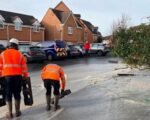On August 28, 2024, a significant fire broke out in downtown Fort Wayne, sending plumes of smoke visible across the city. Interestingly, this smoke was also detected by weather radar, a phenomenon that intrigued many residents. Weather radars, typically used for tracking precipitation, can also detect smoke particles under certain conditions. This capability provided valuable information to emergency responders and the public during the incident, highlighting the versatility of radar technology in disaster management.
The Science Behind Radar Detection of Smoke
Weather radars operate by emitting radio waves that bounce off objects in the atmosphere, such as raindrops, snowflakes, and even smoke particles. When these waves encounter smoke, they are scattered back to the radar, creating a detectable signal. The size, density, and composition of the smoke particles influence the strength of the returned signal, allowing the radar to visualize the smoke plume.
In the case of the Fort Wayne fire, the smoke particles were sufficiently large and dense to be detected by the radar. This detection was facilitated by the radar’s sensitivity settings, which can be adjusted to pick up smaller particles like smoke. The radar images showed the extent and movement of the smoke plume, providing real-time data to emergency responders.

This capability is particularly useful in urban areas where fires can produce large amounts of smoke that pose health risks to residents. By monitoring the smoke plume, authorities can issue timely warnings and take necessary actions to protect public health. The radar data also helps in assessing the fire’s impact on air quality and visibility, crucial for both emergency response and public safety.
Benefits of Radar in Emergency Response
The ability of weather radar to detect smoke has several benefits for emergency response efforts. Firstly, it provides a real-time overview of the smoke plume’s size and movement, which is essential for coordinating firefighting efforts. Firefighters can use this information to strategize their approach, ensuring they tackle the most critical areas first.
Secondly, radar detection of smoke aids in public communication. Authorities can use radar data to inform residents about the fire’s progression and the areas most affected by smoke. This information is vital for issuing evacuation orders, road closures, and health advisories. In the Fort Wayne incident, the radar data helped authorities keep the public informed and safe.
Additionally, radar data can be used to study the fire’s behavior and its interaction with the atmosphere. This information is valuable for improving fire prediction models and developing better firefighting strategies. By understanding how smoke disperses and affects air quality, researchers can enhance their knowledge of fire dynamics and its environmental impact.
Future Implications and Technological Advancements
The use of radar to detect smoke from fires is a promising development in disaster management. As radar technology continues to advance, its applications in emergency response are likely to expand. Future radars may become even more sensitive, capable of detecting smaller particles and providing more detailed information about smoke plumes.
One potential advancement is the integration of radar data with other monitoring systems, such as satellite imagery and ground-based sensors. This integration can create a comprehensive picture of the fire and its effects, enhancing situational awareness for emergency responders. By combining different data sources, authorities can make more informed decisions and improve their response strategies.
Moreover, advancements in artificial intelligence and machine learning could further enhance radar’s capabilities. These technologies can analyze radar data in real-time, identifying patterns and predicting the fire’s behavior. This predictive capability can help authorities anticipate the fire’s progression and take proactive measures to mitigate its impact.
The Fort Wayne fire incident underscores the importance of leveraging advanced technologies in disaster management. By utilizing radar to detect smoke, authorities were able to respond more effectively and protect public health. As technology continues to evolve, its role in emergency response will become increasingly critical, offering new tools and insights to tackle complex challenges.













